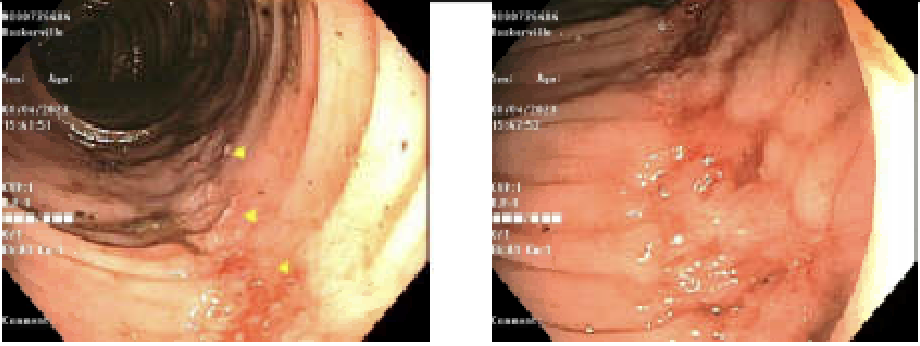Monday Poster Session
Category: Colon
P2561 - Watershed at Risk: Ischemic Colitis in a Patient With Peripheral and Coronary Artery Disease
- TK
Taofeek Kolade, MD, MBA, MPH (he/him/his)
Bayonne Medical Center
Bayonne, NJ
Presenting Author(s)
1CarePoint Health - Bayonne Medical Center, Bayonne, NJ; 2Bayonne Medical Center, North Bergen, NJ; 3CarePoint Health - Bayonne Medical Center, Melville, NY; 4CarePoint Health - Bayonne Medical Center, Jersey City, NJ; 5St. George's University School of Medicine, Belmont, MA; 6Jersey City Medical Center, Jersey City, NJ
Introduction:
Ischemic colitis results from reduced blood flow leading to mucosal inflammation, ulceration, and hemorrhage. Both occlusive and non-occlusive vascular disease contribute to this condition, most commonly affecting the splenic flexure and sigmoid colon. Symptoms include diarrhea, abdominal pain, and hematochezia, necessitating differentiation from colon cancer and infectious colitis. Diagnosis relies on CT with IV contrast, lower GI endoscopy, and histology. While supportive care is the mainstay of treatment, surgical intervention is needed in cases of circulatory compromise or isolated right-sided ischemic colitis. This report details a 73-year-old male presenting with hematochezia and bilateral foot wounds, with findings consistent with ischemic colitis.
Case Description/
Methods:
A 73-year-old male with coronary artery disease, peripheral vascular disease, and hypertension presented with hematochezia. He had a history of multiple vascular interventions and a below-knee amputation. On admission, he was hypotensive and tachycardic, with hemoglobin decreasing from 7.8 to 6.8 g/dL after a large-volume bowel movement. Management included close monitoring, blood transfusions, and withholding Plavix and NSAIDs to minimize bleeding risk. Colonoscopy on hospital day two confirmed ischemic colitis at the splenic flexure, showing a continuous stripe sign. Conservative treatment included parenteral nutrition and hemodynamic support. His ischemic colitis was likely due to chronic vascular disease and acute hypotension.
Discussion:
Ischemic colitis develops when blood supply fails to meet the metabolic demands of the colon. Risk factors include advanced age, comorbidities, and vasoactive medications. Colonoscopy is key for diagnosis, with hallmark findings including the stripe sign—an anti-mesenteric, linear ulcer indicating mesenteric border involvement. Most cases resolve with supportive care, but severe ischemia or right-sided involvement may necessitate surgical resection. Predictors of poor outcomes include age over 75, multi-organ failure, and elevated preoperative lactate levels. Recognizing ischemic colitis early in high-risk patients is critical to ensuring prompt intervention and optimal management.

Figure: Linear Ulceration at the Splenic Flexure: The Stripe Sign Characteristic of Ischemic Colitis
Disclosures:
Philip Hall indicated no relevant financial relationships.
Vikash Chadive indicated no relevant financial relationships.
Taofeek Kolade indicated no relevant financial relationships.
Harman Sawhney indicated no relevant financial relationships.
Mohamed Ahmed indicated no relevant financial relationships.
Sandra Kunnel indicated no relevant financial relationships.
Arsalan Ahmad indicated no relevant financial relationships.
Shreyas Kunjir indicated no relevant financial relationships.
Karim Akl indicated no relevant financial relationships.
Philip Hall, MD, MPH1, Vikash R. Chadive, MBBS2, Taofeek Kolade, MD1, Harman Sawhney, DO3, Mohamed Ahmed, MD4, Sandra S. Kunnel, MBBS1, Arsalan Ahmad, MD1, Shreyas Kunjir, MD5, Karim Akl, MD6. P2561 - Watershed at Risk: Ischemic Colitis in a Patient With Peripheral and Coronary Artery Disease, ACG 2025 Annual Scientific Meeting Abstracts. Phoenix, AZ: American College of Gastroenterology.
